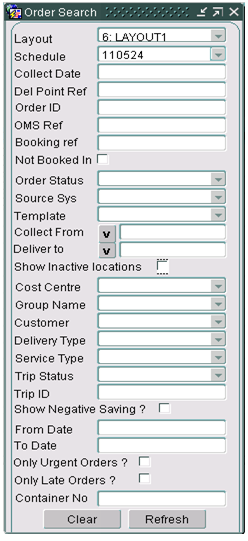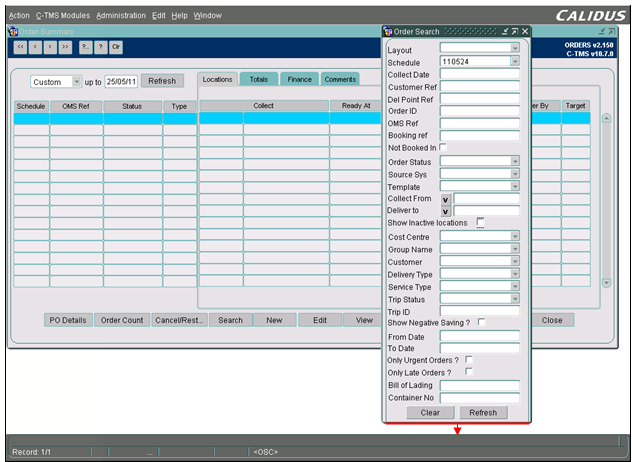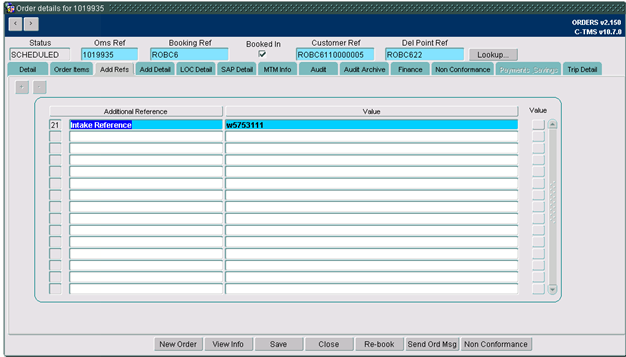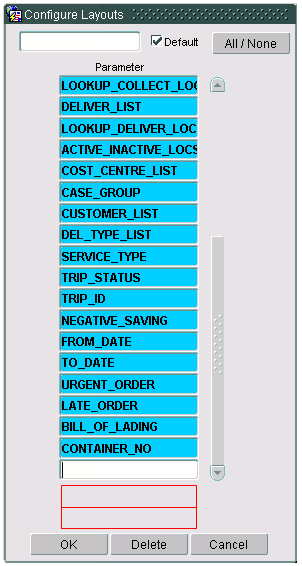288467
![]()
DHL MTS
Additional Fields Order Search
FUNCTIONAL SPECIFICATION - 10.6
- 0.1
Reference: FS 288467 DK-8GL92Q
Client Requirement
Change Request Summary:
To allow the operation to search by the additional reference fields added to the order's in RIO DK-8EME2Y.
Change Request Details:
The operation will need to increase the order search functionality already quoted for in RIO DK-8EME2Y to be able to search by all the additional fields and references that have been added to the order specifically for this contract:
1. Assurance Number2. Haulier Number3. Fixing Number4. Fixing Customer Reference5. Sale Grade6. Intake Reference7. Commodity Code8. Variety Code9. Contract Comments10. Bin Bay Lines11. Bin Bay Comments12. Purchase Number13. Pool14. Sales Number15. Sales Comments16. Purchase Grade17. Sales Commodity18. Weighbridge Ticket Number19. Redirected As Order20. Fixing Comments
21. HL Number
This was requested in the original RIO but was missed by both OBS and DHL on the RIO review and OBS have requested that we submit this additional RIO for the work to be completed.
Benefits identified as a result of the change:
Requirement by the operation to be able to continue providing the service to the customer that they already have.
Solution
The ‘Order Search’ subscreen will be changed to enable the user to include the additional references as search criteria as required.
All of the additional references setup for decode name ‘XML_REFERENCE’ of decode type ‘REFERENCE’ in C-TMS will be available in the configurable layout to be selected as search criteria.
The configurable layout will need to assess the decodes setup and display the ‘Target Value’ as the item name.
Any additional references selected will display the ‘Target Value’ as the title of the item and a field for the value.
As the existing ‘Order Search’ subscreen is limited to 29 items displayed in rows and more items will be available, it will be necessary to increase the length of the subscreen to allow 30 items to be displayed in rows and for a limit on the number of items that may be selected in the configurable layout.
If more than 30 items are selected in the configurable layout then the ‘Order Search’ subscreen will be widened to allow 2 columns of items to be displayed with 30 rows in the first column and up to 30 rows in the second column.
A limit in the configurable layout will be applied to ensure that no more than 60 items may be selected for display.
If all of the decodes for the additional references are made available then it will not be necessary to change the ‘Order Search’ functionality when new references are created.
N.B. If a decode is added then any existing configured layouts for the ‘Order Search’ subscreen will need to be adjusted via a new database update to ensure that the layout is consistent. It will also be assumed that decodes will not be deleted as this would cause a display issues should the deleted decode be still configured for display.
Scope
This change will be applied to system version 10.6.0 on INDTST and once approved INDPRD.
Set-up
Pre-requisites
The new index on table ‘SCH_ORD_REFERENCE’ has been added.
Menu Structure
‘Unchanged’
Data
‘Unchanged’
Functional Description
Decodes
The ‘Order Search’ subscreen will be changed to enable the user to include the additional references as search criteria as required.
All of the additional references setup for decode name ‘XML_REFERENCE’ of decode type ‘REFERENCE’ in C-TMS will be available in the configurable layout to be selected as search criteria.
The configurable layout will need to assess the decodes setup and display the ‘Target Value’ as the item name.
Any additional references selected will display the ‘Target Value’ as the title of the item and a field for the value.
The additional references that exist currently in the ‘INDTST’ database are listed below:
| Source Value | Target Value |
| 1 | Dest Short Name |
| 2 | Dest Assurance |
| 3 | Dest Assurance Number |
| 4 | Dest Scheme |
| 5 | Dest Status |
| 21 | Intake Reference |
| 22 | Sales Commodity |
| 23 | Sales Variety |
| 24 | Sales Grade |
| 25 | Sales Contact Number |
| 26 | HL Number |
| 41 | Source Short Name |
| 42 | Source Assurance |
| 43 | Source Assurance Number |
| 44 | Source Scheme |
| 45 | Source Status |
| 61 | Purchase Contract Number |
| 62 | Purchase Grade |
| 63 | Purchase Comments |
| 64 | Bin/Bay Lines |
| 65 | Bin/Bay Comments |
| 66 | Pool |
| 67 | Variety Code |
| 68 | Commodity Code |
| 69 | Redirect Load |
| 70 | Split Load Identifier |
| 81 | Fixing Number |
| 99 | Weighbridge Ticket Number |
These values may be changed in future and the list will be updated automatically for selection in the configurable layout.
If more decode values are added then it will be necessary to run a process to update all of the existing configurable layouts for the ‘Order Search’ window to ensure that the parameters selected remain compatible with the new decode values.
N.B. It will be assumed that decode values are appended and never deleted otherwise it will not be possible to update the existing configurable layouts automatically.
Decode Trigger
When decode values are appended in the ‘Decodes’ tab page of the ‘Import Maintenance’ screen, or via the XML flow, a trigger called ‘TRG_CONFIG_LAYOUT’ on table ‘IMP_DECODE_ENTRY’ will be called to update any existing configurable layouts.
This trigger will be run when inserting records on the table and need only be active for the ‘Industrial’ database.
The trigger will need to update the value on the ‘ADM_MSEL_FORM_PARAM’ table for form name ‘ORDERS’ and block name ‘ORDER_SEARCH’.
An example of the configured layout called ‘LAYOUT1’ is shown below:
This layout omits the ‘Customer Ref’ and ‘Bill of Lading’ items and produces the following value:
‘LAYOUT1,Y,,,,Y,,Y,,Y,,Y,,Y,,Y,,Y,,Y,,Y,,Y,,Y,,Y,,Y,,Y,,Y,,Y,,Y,,Y,,Y,,Y,,Y,,Y,,Y,,Y,,Y,,,,Y,,Y,,’
As may be seen the ‘Bill of Lading’ is stored as the 2nd item (highlighted in green ink) and the ‘Customer Ref’ is stored as the 3rd to last item (highlighted in the blue ink) in the value; the sequence in which the items are displayed for selection is reversed for storage in the column ‘VALUE’ on table ‘ADM_MSEL_FORM_PARAM’.
Therefore, the trigger will need to insert two commas after the layout name (e.g. ‘LAYOUT1’) for every additional reference appended to the list of decode values.
N.B. A script with the same logic as the trigger will need to be run prior to the implementation of the development in the development, test and production databases will need to be run depending on how many decode values are setup at the time.
Order Search
As the existing ‘Order Search’ subscreen is limited to 29 items displayed in rows and more items will be available, it will be necessary to increase the length of the subscreen to allow 30 items to be displayed in rows (as may be seen in the screenshot above) and for a limit on the number of items that may be selected in the configurable layout.
The 30th item will appear beneath the ‘Container No’ item and above the ‘Clear’ and ‘Refresh’ buttons.
If more than 30 items are selected in the configurable layout then the ‘Order Search’ subscreen will be widened to allow 2 columns of items to be displayed with 30 rows in the first column and up to 30 rows in the second column.
If 31 items are configured for the layout then the 1st column will display the first 30 items and the 2nd column will display the 31st item only at the top of the column, the rest of the column beneath the 31st item will appear as the background colour without items.
If the 2nd column is displayed then the blue rounded rectangle will be extended to encompass the two columns and the ‘Clear’ and ‘Refresh’ buttons will be centralised with regards to the new width of the ‘Order Search’ window.
The new items for the additional references will be of uniform size and will have data type ‘VARCHAR2(512)’; none of the new items will have a list of values or be validated as the value entered will be accepted; the titles of the new items will have data type ‘VARCHAR2(50)’.
The new items will be used to select orders for the corresponding additional reference but only if the parameter is set; the ‘where’ clause compiled in program unit ‘F_REFRESH_ORDER_SUMMARY’ in the ‘ORDERS’ from will be changed to assess each of the new items that have been set when the order search is instigated via the ‘Refresh’ button.
The new items will validate against column ‘SUB_REF_VALUE’ on table ‘SCH_ORD_REFERENCES’ using the decoded value in column ‘SUB_REF_NAME’
For example, if the new item with the title ‘Intake Reference’ is entered as ‘w5753111’ then order ‘1019935’ will be selected provided that it satisfies the other selection criteria.
N.B. Partial searches will not be possible for the new items.
A new normal index will be added to table ‘SCH_ORD_REFERENCE’ with column ‘SUB_REF_NAME’ to allow quicker access of the orders for the new items.
Configurable Layout
A limit in the configurable layout will be applied to ensure that no more than 60 items may be selected for display.
Two new items called ‘Current Items Selected’ and ‘Maximum Number of Items’ will be added after the ‘Parameter’ data block: these will display the current number of items selected for display and a non-editable maximum number of items that may be displayed (i.e. ‘60’).
If the maximum number of items is exceeded during selection when the user presses the ‘OK’ button, then the error message ‘The maximum number of items that may be displayed in the Order Search has been exceeded and must be reduced.’ will be issued and the item deselected.
The existing check to ensure that at least one item has been selected will be retained.
If all of the decode values for the additional references are made available then it will not be necessary to change the ‘Order Search’ functionality when new references are created.
References
| EST-288467 DK-8GL92Q Additional Fields Order Search v1.0.doc | |||
Glossary
| C-TMS | Calidus TMS |
Document History
| Initial version | ||||
AUTHORISED BY
| Matt Crisford | Development Manager | |
| Peter Greer | TMSCC MTS Product Manager |



